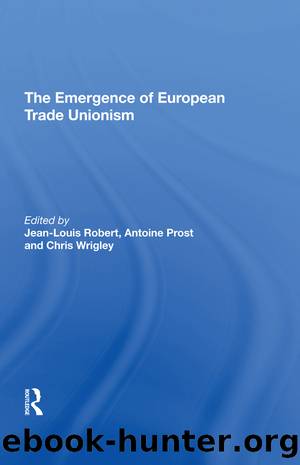The Emergence of European Trade Unionism by Jean-Louis Robert

Author:Jean-Louis Robert [Robert, Jean-Louis]
Language: eng
Format: epub
Tags: History, General
ISBN: 9781351146869
Google: cLlHDwAAQBAJ
Publisher: Routledge
Published: 2018-01-18T05:04:13+00:00
The cities: structure and identity
Population
By the end of the nineteenth century, Liverpool, Lyon and Munich were substantial cities: the 1901 census listed Liverpool Borough as having 684958 inhabitants, while calculations for the greater Lyon area and Munich in 1900 have produced figures of 507000 and 490000 respectively. The pace and pattern of demographic growth of each city, however, differed significantly. Liverpool grew inexorably, although by 1880â1900 there was considerable outmigration from increasingly unattractive inner residential areas. The most rapid growth, indeed, was outside the recently enlarged borough boundary: the wider Merseyside conurbation (the whole of Liverpool, West Derby, Birkenhead and Wirral registration districts along with the Huyton, Much Woolton and Hale subdistricts of the Prescot registration district) grew from 817821 in 1881 to 1022748 in 1901. In Lyon, there was a similar expansion and annexation of the built-up area â la Guillotière, la Croix Rousse and Vaise were annexed in 1851 â but the growth rate began to level off towards the end of the century. Population growth (along with modern factory development) was restricted to the outer suburbs and unannexed townships, such as Villeurbanne where the population doubled from around 20000 in 1896 to about 40000 in 1911. In Munich, by contrast, long-term population growth accelerated dramatically at this stage: the population more than doubled between 1882 (240000) and 1900 (490000), a faster rate than in comparable German cities. Thereafter, there was a marked deceleration until after the First World War.
Inmigration was the main factor of growth in all three cases, but Liverpool, a major port of entry for migrants and a human entrepôt for transcontinental emigration, was a case apart. In Lyon and Munich, inmigration was preponderantly short-distance, essentially from adjacent rural and out-working areas, from a hinterland of shared culture, religion and regional identity. Figures for newly married members of the working class in Lyon in 1911 show that only 4 per cent of the women and 4.7 per cent of the men were born outside France. However, there was a significant Italian presence in small shops and businesses in working-class areas. Among the working class, in fact, there was a certain reticence towards Italians, even in trade unions. In Munich, where two-thirds of the workforce in 1907 had been born outside the city, some 90 per cent of inmigrants came from Bavaria. Liverpool, by contrast, attracted long-distance migrants, primarily the Irish (22.3 per cent of the population in 1851 was Irish-born), but also significant numbers of Welsh and Scots. Where rural inmigration into Lyon and Munich served to reinforce their culture, character and status as regional capitals, the multi-ethnic, mainly celtic inflow transformed Liverpool, setting it apart from surrounding Lancashire (and from the rest of England). The âmelting-potâ of inmigration gave Liverpool its unique identity, a construction riven with considerable cultural, sectarian and political divisions.
Download
This site does not store any files on its server. We only index and link to content provided by other sites. Please contact the content providers to delete copyright contents if any and email us, we'll remove relevant links or contents immediately.
The Power and the Money by Tevi Troy(392)
The Enemy What Every American Should Know About Imperialism by Unknown(273)
Jeep Jamboree by evilbadman.com(263)
The Truth About Watergate by Nick Bryant;(261)
On The Waterfront by Linda M. Priestley(252)
Caesars of the wilderness by Peter Charles Newman(245)
Exposing the Expositions 1851-1915: Revised 2021 by Howdie Mickoski(232)
Damn the Tores A Short History of U.S. Naval Mine Countermeasures, 1777-1991 by Unknown(230)
The Ruby Ridge Siege: The History of the Federal Governmentâs Deadly Standoff with Randy Weaver and His Family by Charles River Editors(212)
First Day at Gettysburg : Crisis at the Crossroads by Warren W. Hassler Jr(210)
The Great Los Angeles Swindle: Oil, Stocks, and Scandal During the Roaring Twenties by Jules Tygiel(192)
The Stolen Election by Lloyd Robinson(157)
History of Blacks in America from Pre-History to 1877 by Clyde Winters(155)
The Expedition of the Donner Party and Its Tragic Fate by Eliza P. Donner Houghton(148)
Inside Lincoln's Cabinet; The Civil War Diaries Of Salmon P. Chase by Salmon P. Chase David Herbert Donald(146)
Pioneers of the Old South: A Chronicle of English Colonial Beginnings by Mary Johnston Allen Johnson(136)
The 1966 Green Bay Packers by George Bozeka(134)
The gunfighters by Time-Life Books(132)
The Emergence of European Trade Unionism by Jean-Louis Robert(131)
